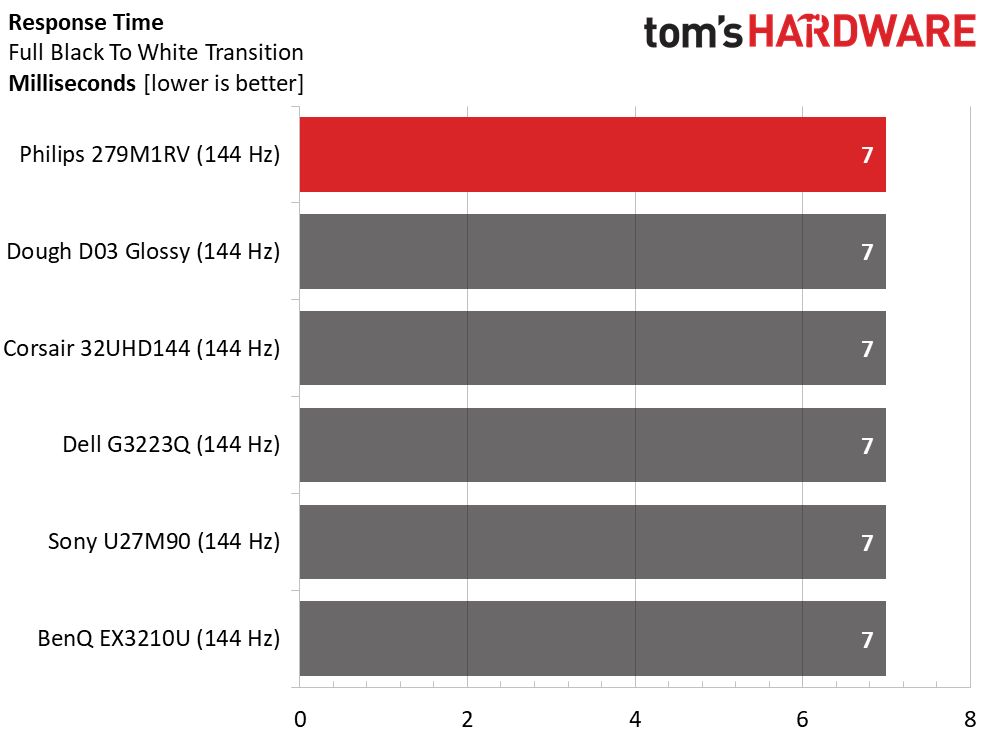Why you can trust Tom's Hardware
I have plenty of 4K 144 Hz screens to add to the mix with the 279M1RV. The Dough D03 Glossy is a reference-quality display and the Sony U27M90 isn’t far behind that description. At 32 inches are Dell’s G3223Q, BenQ’s EX3210U and Corsair’s 32UHD144.
Pixel Response and Input Lag
Click here to read up on our pixel response and input lag testing procedures.


A 144 Hz monitor will almost universally score 7 ms in my full field white draw test. The resolution does not affect the result. The difference in motion quality comes down to the monitor’s overdrive. The 279M1RV is one of the best I’ve seen with fixed options. The Dough is the only monitor with a multi-step approach that lets you dial in the overdrive level very precisely. The Philips manages to hit the mark on its Faster setting. The other screens are close behind, but the Philips and Dough are standouts in the motion processing department.
The 279M1RV has lower input lag than any 4K monitor I’ve tested, except for the Acer XV282K. At 29 ms, it comes close to some of the 240 Hz screens I’ve reviewed. That translates to a super quick control response that is a real treat for a gamer of my average skills. Thanks to the Philips ' near-perfect motion processing, I ripped through intense battles with ease.
Viewing Angles
The 279M1RV has excellent off-axis image quality with a barely perceptible reduction in brightness and only the slightest color shift to red/green. Detail remains clear in highlight and shadow areas, more so than many IPS monitors I've photographed. It is one of the best I’ve seen in this test. The top view is typical of IPS panels with a blue tint and washed-out look. One could easily share this monitor with another player.
Screen Uniformity
To learn how we measure screen uniformity, click here.
Premium monitors like the 279M1RV rarely have visible uniformity issues and my sample was among the best in class. With just 8.1% average deviation from the center zone, I could not see any visible glow or bleed. Color and brightness were visually perfect in all patterns and at all brightness levels.
Get Tom's Hardware's best news and in-depth reviews, straight to your inbox.
MORE: Best Gaming Monitors
MORE: How We Test PC Monitors
MORE: How to Buy a PC Monitor: A 2022 Guide
MORE: How to Choose the Best HDR Monitor
Current page: Response, Input Lag, Viewing Angles and Uniformity
Prev Page Features and Specifications Next Page Brightness and Contrast
Christian Eberle is a Contributing Editor for Tom's Hardware US. He's a veteran reviewer of A/V equipment, specializing in monitors. Christian began his obsession with tech when he built his first PC in 1991, a 286 running DOS 3.0 at a blazing 12MHz. In 2006, he undertook training from the Imaging Science Foundation in video calibration and testing and thus started a passion for precise imaging that persists to this day. He is also a professional musician with a degree from the New England Conservatory as a classical bassoonist which he used to good effect as a performer with the West Point Army Band from 1987 to 2013. He enjoys watching movies and listening to high-end audio in his custom-built home theater and can be seen riding trails near his home on a race-ready ICE VTX recumbent trike. Christian enjoys the endless summer in Florida where he lives with his wife and Chihuahua and plays with orchestras around the state.
-
cknobman "That means it won’t quite deliver the dynamic contrast of a full-array local-dimming (FALD) model, but it will render solid HDR with deep blacks and bright highlights. "Reply
Stopped reading right there.
I call bs as no IPS with edge lit dimming is actually capable of delivering a real HDR experience.
Then looked at price and laughed even harder. $750!!!
Phillips be smokin crack, LMAO -
Sergei Tachenov Reply
Absolutely. You need all three things to deliver any HDR experience: brightness, contrast and color gamut. And the contrast is what, 1000:1? Laughable. That's not "deep blacks." It's just a very bright SDR monitor with wide color gamut, nothing special. In fact, it's just the Philips version of the 27GP950, sharing the same panel.cknobman said:"That means it won’t quite deliver the dynamic contrast of a full-array local-dimming (FALD) model, but it will render solid HDR with deep blacks and bright highlights. "
Stopped reading right there.
I call bs as no IPS with edge lit dimming is actually capable of delivering a real HDR experience.
On an unrelated note, I wonder whether the KVM switch is as broken as in the 329M1RV. I'm 99% sure it is. Because they call it a KVM switch except... there is no freaking switch! There are exactly two ways to switch between the connected devices. The first, use the "auto-switch" feature: turn one PC off, the monitor will automatically switch to the other. The second, dig all the way through the OSD to find the carefully hidden switch functionality. And nope, you can't set it up to some shortcut, like moving the joystick into a certain direction.
This is the reason why I chose the M32U over the 329M1RV. Here, the switch comes with a lot of flaws, but at least it's there, and it actually works.
Philips has a very unique talent of making a horrible mess of UX. I had a Philips TV where plugging earphones in didn't mute the speakers. Instead, you had to mute them manually and then, to adjust the phones' volume, you had to dig through the menu to find it because the volume buttons on the remote control only controlled speakers regardless of whether earphones are connected.

